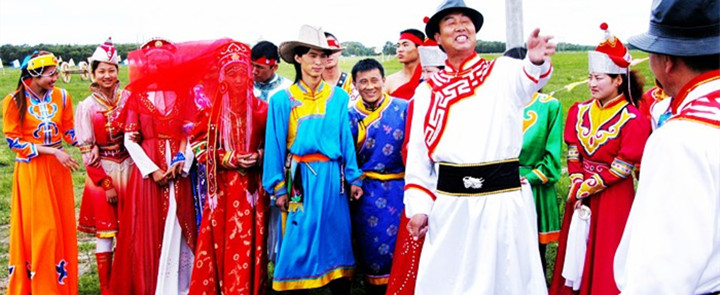

Mongol Ethnic Minority


The Mongolians live mostly in the Inner Mongolia Autonomous Region, with the rest residing in Liaoning, Jilin, Heilongjiang, Xinjiang, Qinghai, Gansu, Ningxia, Hebei, Henan, Sichuan, Yunnan and Beijing. /Having their own spoken and written language, which belongs to the Mongolian group of the Altaic language family, the Mongolians use three dialects: Inner Mongolian, Barag-Buryat and Uirad. The Mongolian script was created in the early 13th century on the basis of the script of Huihu or ancient Uygur, which was revised and developed a century later into the form used to this day.
The largest Mongolian area, the Inner Mongolia Autonomous Region with its capital at Hohhot, was founded on May 1, 1947, as the earliest such establishment in China. This vast and rich expanse of land is inhabited by 21,780,000 people, of whom about 2 million are Mongolians and the rest Hans, Huis, Manchus, Daurs, Ewenkis, Oroqens and Koreans.
The Inner Mongolia Autonomous Region is located in the northern part of China. Covering 1.2 million square kilometers and rising 900 to 1,300 meters above sea level, it has vast tracts of excellent natural pastureland with numerous herds of cattle, sheep, horses and camels. The Yellow River Bend and Tumochuan plains, known as a "Granary North of the Great Wall," are crisscrossed with streams and canals. Over southwestern Inner Mongolia flows the Yellow River, which is, among other things, famous for its carp and the well-developed irrigation and transport facilities it has provided for the area. Inner Mongolia also has several hundred richly endowed salt and alkali lakes and many large freshwater lakes, including Hulun Nur, Buir Nur, Ulansu Nur, Dai Hai and Huangqi Hai. More than 60 mineral resources such as coal, iron, chromium, manganese, copper, lead, zinc, gold, silver, tin, mica, graphite, rock crystal and asbestos have been found. The Greater Hinggan Mountain Range in the east part of the region boasts China's largest forests, which are also a fine habitat for a good many rare species of wildlife. This unique natural environment makes the region a famous producer of precious hides, pilose antler, bear gallbladder, musk, Chinese caterpillar fungus (Cordyceps sinensis), as well as 400 varieties of Chinese medicinal herbs, including licorice root, "dangshen" (Codonopsis pilosula), Chinese ephedra (Ephedra sinica), and the root of membranous milk vetch (Astragalus membranaceus). Specialities of the region known far and wide are mushrooms and day lily flowers, which enjoy brisk sales on both the domestic and world markets.
Following the founding of the Inner Mongolia Autonomous Region, autonomous prefectures and counties were established in other provinces where Mongolians live in large communities. These include the two Mongolian autonomous prefectures of Boertala and Bayinguoleng in Xinjiang, the Mongolian and Kazak Autonomous Prefecture in Qinghai, and the seven autonomous counties in Xinjiang, Qinghai, Gansu, Heilongjiang, Jilin and Liaoning. Enjoying the same rights as all other nationalities in China, the Mongolians are joining them in running the country as its true masters.
You will only receive emails that you permitted upon submission and your email address will never be shared with any third parties without your express permission.
